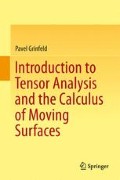Abstract
In the preceding chapter, we gave an overview of embedded surfaces. We now turn to the important question of covariant differentiation on the surface. We will divide the construction of the covariant derivative into two parts. We will first define this operator for objects with surface indices. The definition will be completely analogous to that of the covariant derivative in the ambient space. While the definition will be identical, some of the important characteristics of the surface covariant derivative will be quite different. In particular, surface covariant derivatives do not commute. Our proof of commutativity for the ambient derivative was based on the existence of affine coordinates in Euclidean spaces. Since affine coordinates may not be possible on a curved surface, that argument is no longer available. We will also discover that the surface covariant derivative is not metrinilic with respect to the covariant basis S α. This will prove fundamental and will give rise to the curvature tensor, which will be further developed in Chap. 12
Access this chapter
Tax calculation will be finalised at checkout
Purchases are for personal use only
Bibliography
L. Bewley. Tensor Analysis of Electric Circuits and Machines. Ronald Press, 1961.
A. Borisenko and I.E.Tarapov. Vector and Tensor Analysis with Applications. Dover Publications, New York, 1979.
S. Carroll. Spacetime and Geometry: An Introduction to General Relativity. Benjamin Cummings, 2003.
E. Cartan. Geometry of Riemannian Spaces. Math Science Pr, 1983.
E. Cartan. Riemannian Geometry in an Orthogonal Frame: From Lectures Delivered by Elie Cartan at the Sorbonne in 1926–27. World Scientific Pub Co Inc, 2002.
I. Chavel. Riemannian Geometry: A Modern Introduction (Cambridge Studies in Advanced Mathematics). Cambridge University Press, 2006.
E. Christoffel. Sul problema delle temperature stazionarie e la rappresentazione di una data superficie. Annali di Matematica Pura ed Applicata, 1(1):89–103, 1867. On the problem of stationary temperature and the representation of a given area.
D. Danielson. Vectors And Tensors In Engineering And Physics: Second Edition. Westview Press, 2003.
R. Descartes. The Geometry. Dover Publications, New York, 1954.
A. Einstein. Die grundlage der allgemeinen relativittstheorie. Ann. der Physik, 49:769–822, 1916.
Euclid. The Elements: Books I - XIII - Complete and Unabridged. Barnes & Noble, 2006.
L. Euler. Methodus inveniendi lineas curvas maximi minimive proprietate gaudentes, sive solutio problematis isoperimetrici lattissimo sensu accepti. Opera Omnia, 24(1), 1897.
I. Gelfand. Lectures on Linear Algebra. Dover Publications, New York, 1989.
J. W. GIbbs. Vector analysis: A text-book for the use of students of mathematics and physics. Dover Publications, 1960.
I. Grattan-Guiness. From the calculus to set theory, 1630–1910: an introductory history. Princeton University Press, Princeton, 2000.
M. Grinfeld. Thermodynamic Methods in the Theory of Heterogeneous Systems. Longman, New York, NY, 1991.
P. Grinfeld. Exact nonlinear equations for fluid films and proper adaptations of conservation theorems from classical hydrodynamics. J. Geom. Symm. Phys., 16:1–21, 2009.
P. Grinfeld. Hamiltonian dynamic equations for fluid films. Stud. Appl. Math., 125:223–264, 2010.
P. Grinfeld. A variable thickness model for fluid films under large displacements. Phys. Rev. Lett., 105:137802, 2010.
P. Grinfeld. A better calculus of moving surfaces. J. Geom. Symm. Phys., 26:61–69, 2012.
J. Hadamard. Mmoire sur le problme d’analyse relatif l’quilibre des plaques elastiques encastres, Oeuvres, tome 2. Hermann, 1968.
P. Halmos. Finite-dimensional vector spaces. Springer-Verlag, New York, 1974.
F. Harley. Differential forms, with applications to the physical sciences. Academic Press, New York, 1963.
V. Katz. The history of stokes’ theorem. Helv. Phys. Acta. Supp., 52(3):146–156, 1979.
L. Kollros. Albert einstein en suisse souvenirs. Helv. Phys. Acta. Supp., 4:271–281, 1956.
J. Lagrange. Essai d’une nouvelle mthode pour dterminer les maxima et les minima des formules intgrales indfinies. Miscellanea Taurinensia, 1761.
P. Lax. Linear algebra and its applications. Wiley-Interscience, Hoboken, N.J, 2007.
T. Levi-Civita. The Absolute Differential Calculus (Calculus of Tensors). Dover Publications, 1977.
S. Lovett. Differential Geometry of Manifolds. A K Peters Ltd, 2010.
J. Maxwell. Treatise on Electricity and Magnetism. Cambridge University Press, Cambridge, 2010.
A. McConnell. Applications of Tensor Analysis. Dover Publications, New York, 1957.
F. Morgan. Riemannian Geometry: A Beginners Guide, Second Edition. A K Peters/CRC Press, 1998.
P. Nastasia and R. Tazzioli. Toward a scientific and personal biography of Tullio Levi-Civita. Historia Mathematica, 32(2):203–236, 2005.
G. Ricci and T. Levi-Civita. Mthodes de calcul diffrentiel absolu et leurs applications. Mathematische Annalen, 54:125–201, 1900.
B. Riemann. Ueber die hypothesen, welche der geometrie zu grunde liegen. Abhandlungen der Kniglichen Gesellschaft der Wissenschaften zu Gttingen, 13, 1867. On the hypotheses that lie at the foundation of geometry.
B. Riemann. Gesammelte Mathematische Werke. Unknown, 1919. The Collected Mathematical Works with commentary by Hermann Weyl.
B. Riemann. Sochineniya. GITTL, 1948. The Collected Mathematical Works with commentary by Hermann Weyl, in Russian.
W. Rudin. Principles of mathematical analysis. McGraw-Hill, New York, 1976.
H. Schwarz. Sur une definition erronee de aire d’une surface courbe. Ges. Math. Abhandl, 2:309–311, 369–370, 1882.
J. Simmonds. A brief on Tensor Analysis. Springer, New York Berlin, 1994.
I. Sokolnikoff. Tensor Analysis: Theory and Applications to Geometry and Mechanics of Continua. Krieger Pub Co, 1990.
B. Spain. Tensor Calculus: a concise course. Dover Publications, Mineola, N.Y, 2003.
M. Spivak. Calculus on manifolds: a modern approach to classical theorems of advanced calculus. W.A. Benjamin, New York, 1965.
G. Strang. Introduction to Linear Algebra, 4th edition. Wellesley-Cambridge Press, 2009.
T. Thomas. Plastic Flow and Fracture in Solids. Academic Press, New York, NY, 1961.
T. Thomas. Concepts from Tensor Analysis And Differential Geometry. Academic Press, New York, 1965.
H. Weyl. Space, Time, Matter. Dover Publications, 1952.
F. Zames. Surface area and the cylinder area paradox. The Two-Year College Mathematics Journal, 8(4):207–211, 1977.
Author information
Authors and Affiliations
Rights and permissions
Copyright information
© 2013 Springer Science+Business Media New York
About this chapter
Cite this chapter
Grinfeld, P. (2013). The Covariant Surface Derivative. In: Introduction to Tensor Analysis and the Calculus of Moving Surfaces. Springer, New York, NY. https://doi.org/10.1007/978-1-4614-7867-6_11
Download citation
DOI: https://doi.org/10.1007/978-1-4614-7867-6_11
Published:
Publisher Name: Springer, New York, NY
Print ISBN: 978-1-4614-7866-9
Online ISBN: 978-1-4614-7867-6
eBook Packages: Mathematics and StatisticsMathematics and Statistics (R0)

